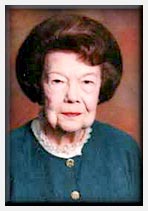W.R. Beydler Brought Movies And Electric Lights To Pampa |
|
 Eloise Lane
Eloise Lane
W.R. Beydler, who came to Pampa in about 1912, was one of the committee backers. He aquired an engine for theater purposes from the Nunns of Amarillo and operated Pampa 's first picture show at 123 North Cuyler in a building that seated 100. The first movies, powered by a dynamo on the back of the lot, were one-reelers that were shown once a week.
One night the screen went black for half an hour, after which Beydler announced, "No more show tonight, folks. She's busted her belt!"
Beydler also ran a lumber yard and was the town's funeral director. He was not an undertaker, but he kept four caskets on hand and held services when there was a death. The hearse was the White Deer Land Company's hack with the back seat removed.
When Beydler found that his engine was capable of producing more "Juice" than he had anticipated, he made a contract with town officials to furnish street lights.
In 1914 and 1915 electric lights were distinct novelties in Pampa and curious residents used to watch Beydler turn on the lights. Dr. Walter Purviance, mayor of Pampa in 1915, told of a street light located near the home of Lee Ledrick. In the evenings Beydler would say to the group watching his engine generate "juice," "Now watch her go on!" He would push a lever and the light would shine before the spectators could run to the corner and watch the miracle.
After Beydler released his franchise, it was given to W.P. Davis in 1917 and a larger engine was purchased. But lights went off at midnight and participants in card or domino games usually could not induce the engineer to keep the engine running for love or money.
Until the first incandescent bulbs came to town, people used kerosene lamps and then gas lamps in their homes. A small hollow tube was used to connect a gasoline lamp to a gasoline tank somewhere back of the house. When air was pumped into the tank, the resulting gas supplied light when ignited at the mantle. Dr. Purviance reported that the mantles were always crumbling.
Early movies had no soundtracks, and accompanying sound effects (if there were any) were usually provided by local talent. Elsie Lard (Mrs. Roy Hall) and Eula Meadows (Mrs Lewis F. Meers were among those who provided background music for early movies in Pampa .
Gray County Bicentennial Souvenir Booklet, p. 18
Gray County Heritage, p. 81
The Pampa Daily News, March 8, 1933
One night the screen went black for half an hour, after which Beydler announced, "No more show tonight, folks. She's busted her belt!"
Beydler also ran a lumber yard and was the town's funeral director. He was not an undertaker, but he kept four caskets on hand and held services when there was a death. The hearse was the White Deer Land Company's hack with the back seat removed.
When Beydler found that his engine was capable of producing more "Juice" than he had anticipated, he made a contract with town officials to furnish street lights.
In 1914 and 1915 electric lights were distinct novelties in Pampa and curious residents used to watch Beydler turn on the lights. Dr. Walter Purviance, mayor of Pampa in 1915, told of a street light located near the home of Lee Ledrick. In the evenings Beydler would say to the group watching his engine generate "juice," "Now watch her go on!" He would push a lever and the light would shine before the spectators could run to the corner and watch the miracle.
After Beydler released his franchise, it was given to W.P. Davis in 1917 and a larger engine was purchased. But lights went off at midnight and participants in card or domino games usually could not induce the engineer to keep the engine running for love or money.
Until the first incandescent bulbs came to town, people used kerosene lamps and then gas lamps in their homes. A small hollow tube was used to connect a gasoline lamp to a gasoline tank somewhere back of the house. When air was pumped into the tank, the resulting gas supplied light when ignited at the mantle. Dr. Purviance reported that the mantles were always crumbling.
Early movies had no soundtracks, and accompanying sound effects (if there were any) were usually provided by local talent. Elsie Lard (Mrs. Roy Hall) and Eula Meadows (Mrs Lewis F. Meers were among those who provided background music for early movies in Pampa .
Gray County Bicentennial Souvenir Booklet, p. 18
Gray County Heritage, p. 81
The Pampa Daily News, March 8, 1933

